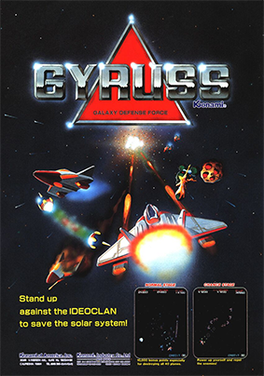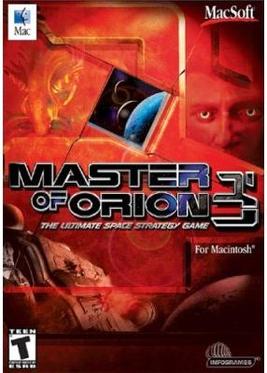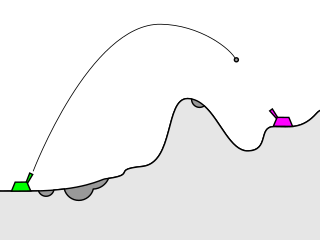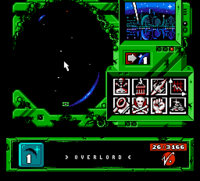
Missile Command is a 1980 shoot 'em up arcade video game developed and published by Atari, Inc. and licensed to Sega for Japanese and European releases. It was designed by Dave Theurer, who also designed Atari's vector graphics game Tempest from the same year. The game was released during the Cold War, and the player uses a trackball to defend six cities from intercontinental ballistic missiles by launching anti-ballistic missiles from three bases.

Master of Orion is a turn-based, 4X science fiction strategy game in which the player leads one of ten races to dominate the galaxy through a combination of diplomacy and conquest while developing technology, exploring and colonizing star systems.

Contra is a run and gun video game developed and published by Konami, originally developed as a coin-operated arcade video game in 1986 and released on February 20, 1987. A home version was released for the Nintendo Entertainment System in 1988, along with ports for various home computer formats, including the MSX2. The arcade and computer versions were localized as Gryzor in Europe, and the NES version as Probotector in PAL regions.

Gyruss is shoot 'em up arcade video game designed by Yoshiki Okamoto and released by Konami in 1983. Gyruss was initially licensed to Centuri in the United States for dedicated machines, before Konami released their own self-distributed conversion kits for the game. Parker Brothers released contemporary ports for home systems. An enhanced version for the Family Computer Disk System was released in 1988, which was released to the North American Nintendo Entertainment System in early 1989.
Renegade Legion is a series of science fiction games that were designed by Sam Lewis, produced by FASA, and published from 1989 to 1993. The line was then licensed to Nightshift games, a spin-off of the garage company Crunchy Frog Enterprises by Paul Arden Lidberg, which published one scenario book, a gaming aid, and three issues of a fanzine-quality periodical before reverting the license.

Ascendancy is a 4X science fiction turn-based strategy computer game. It was originally released for MS-DOS in 1995 and was updated and re-released for iOS in 2011 by The Logic Factory. Ascendancy is a galactic struggle to become the dominant life form, hence the title. The game's introductory cinematic states: "Wildly different cultures competed for the same worlds. In the enormous upheaval that followed, one of these species would gain ascendancy."
DECWAR is a multiplayer computer game first written in 1978 at the University of Texas at Austin for the PDP-10. It was developed from a lesser-known two-player version, WAR, adding multi-terminal support for between one and ten players. WAR and DECWAR are essentially multiplayer versions of the classic Star Trek game, but with added strategic elements. The game was later used, by scrubbing copyright notices and replacing them, as MegaWars on CompuServe and Stellar Warrior on GEnie. Both versions ran for years.

Jackal, also distributed under the title of Top Gunner, is an overhead run and gun video game by Konami released for arcades in 1986. The player must maneuver an armed jeep in order to rescue prisoners of war (POWs) trapped in enemy territory.

Galactic Civilizations II: Dread Lords is a 4X turn-based strategy by Stardock for Microsoft Windows. It is the sequel to the 2003 game, Galactic Civilizations, and was released at retail and on Stardock's online subscription service, TotalGaming.net, on February 21, 2006. An expansion, Dark Avatar, was released in February 2007. A second expansion, Twilight of the Arnor, was released in April 2008.

Master of Orion II: Battle at Antares is a 4X turn-based strategy game set in space, designed by Steve Barcia and Ken Burd, and developed by Simtex, who developed its predecessor Master of Orion and Master of Magic. The PC version was published by MicroProse in 1996, and the Macintosh version a year later by MacSoft, in partnership with MicroProse. The game has retained a large fan base, and is still played online.

Star Force, also released in arcades outside of Japan as Mega Force, is a vertical-scrolling shooter computer game released in 1984 by Tehkan.

Stellar 7 is a first-person shooter tank simulation video game based on the arcade game Battlezone in which the player assumes the role of a futuristic tank pilot. The game was originally created by Damon Slye for the Apple II and Commodore 64 in 1983. It was followed by three sequels: Arcticfox (1986), Nova 9: The Return of Gir Draxon (1991), and Stellar 7: Draxon's Revenge (1993). It was remade in the early 1990s for the 16-bit computers.

Starglider 2 is a 3D space combat simulator published in 1988 by Rainbird as the sequel to 1986's Starglider. It was released for the Amiga, Atari ST, MS-DOS, Macintosh, and ZX Spectrum. Instead of the wireframe graphics of the original, Starglider 2 uses flat shaded polygons.

Master of Orion III is a 4X turn-based strategy game and the third in the Master of Orion series. Master of Orion III was developed by Quicksilver Software and published by Infogrames Interactive on February 25, 2003.

Laser Invasion, released as Gun Sight (ガンサイト) in Japan, is a multi-genre first-person action game released by Konami for the Nintendo Entertainment System in 1991. The player takes control of a military operative who pilots an attack helicopter in order to infiltrate various enemy bases and fulfill his mission. The game supports the standard NES controller, as well as the NES Zapper light gun and the LaserScope, a voice-activated headset controller Konami released for the NES that was compatible with all light gun games released for the system. The American version of the game featured a rebate for the LaserScope in the instruction booklet.

Sins of a Solar Empire is a 2008 science fiction real-time strategy video game developed by Ironclad Games and published by Stardock Entertainment for Microsoft Windows operating systems. It is a real-time strategy (RTS) game that incorporates some elements from 4X games; its makers describe it as "RT4X". Players are given control of a spacefaring empire in the distant future, and are tasked with conquering star systems using military, economic and diplomatic means.

Artillery games are two or three-player video games involving tanks trying to destroy each other. The core mechanics of the gameplay is almost always to aim at the opponent(s) following a ballistic trajectory. Artillery games are among the earliest computer games developed; the theme of such games is an extension of the original uses of computer themselves, which were once used to calculate the trajectories of rockets and other related military-based calculations. Artillery games have been described as a type of "shooting game", though they are more often classified as a type of strategy video game.

Sid Meier's Pirates! is a 2004 strategy, action and adventure video game developed by Firaxis Games. A remake of Sid Meier's earlier 1987 game of the same name, it was originally published by Atari Interactive but in May 2005 2K acquired the rights to the title from Atari's parent company Infogrames and later went on to publish console and handheld ports of the game.

Pardus is a graphical browser-based MMORPG written in PHP and C/C++ and set in a futuristic universe where players interact and compete in space. It is a persistent-universe, open-ended game with a player-driven economy. Players travel through hundreds of "sectors" or solar systems while trading, building or battling with Non-Player Characters (NPCs) and other players. There are dozens of spacecraft models in Pardus, which can be customized with different weapons, armor and other equipment. Pardus characters do not have a defined 'class'.

Captain Commando is a 1991 futuristic side-scrolling beat 'em up originally developed and published by Capcom as an arcade video game, and later ported to several other platforms. It was the seventeenth game produced for the company's CP System hardware. The game stars the titular superhero who was originally conceived as a fictional spokesman used by Capcom USA in the company's console games during the late 1980s. On September 13, 2018, Capcom announced Capcom Beat 'Em Up Bundle with Captain Commando being one of seven titles and released digitally for Nintendo Switch, PlayStation 4, Xbox One, and Windows on September 18, 2018.



















